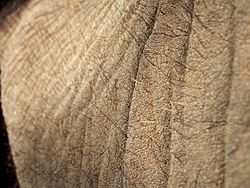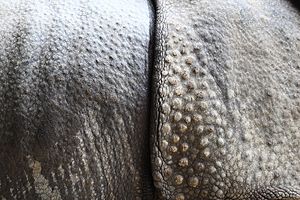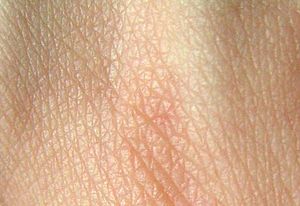Skin facts for kids
Quick facts for kids Skin |
|
|---|---|
 |
|
| Skin of an elephant | |
| Latin | Cutis |

Skin is the outside covering of animals. The skin of different kinds of animals is very different. Many kinds of animals have hair or fur on their skin. Birds have feathers on their skin. Most fish, and reptiles, like snakes and lizards, have scales on their skin.
The skin of human beings usually has very small hairs on it that are hard to see. Some people have more hair, or hair that is easier to see, and some have less. People have hair that is longer and easier to see on some parts of their bodies, such as the tops of their heads and men's beards.
The skin of cows can be made into leather. Leather is sometimes used to make shoes, bags, and balls.
Other things can be said to have "skins". People often say that fruits, such as apples and bananas, and vegetables, such as potatoes, have "skins".
Functions
Skin performs the following functions:
- Protection: an anatomical barrier from pathogens and damage between the internal and external environment in bodily defense. Langerhans cells in the skin are part of the adaptive immune system.
- Sensation: contains a variety of nerve endings that jump to heat and cold, touch, pressure, vibration, and tissue injury (see somatosensory system and haptic perception).
- Thermoregulation: Eccrine (sweat) glands and dilated blood vessels (increased superficial perfusion) aid heat loss, while constricted vessels greatly reduce cutaneous blood flow and conserve heat. Erector pili muscles in mammals adjust the angle of hair shafts to change the degree of insulation provided by hair or fur.
- Control of evaporation: the skin provides a relatively dry and semi-impermeable barrier to reduce fluid loss.
- Storage and synthesis: acts as a storage center for lipids and water
- Absorption through the skin: Oxygen, nitrogen and carbon dioxide can diffuse into the epidermis in small amounts; some animals use their skin as their sole respiration organ (in humans, the cells comprising the outermost 0.25–0.40 mm of the skin are "almost exclusively supplied by external oxygen", although the "contribution to total respiration is negligible") Some medications are absorbed through the skin.
- Water resistance: The skin acts as a water resistant barrier so essential nutrients aren't washed out of the body. The nutrients and oils that help hydrate the skin are covered by the most outer skin layer, the epidermis. This is helped in part by the sebaceous glands that release sebum, an oily liquid. Water itself will not cause the elimination of oils on the skin, because the oils residing in our dermis flow and would be affected by water without the epidermis.
- Camouflage, whether the skin is naked or covered in fur, scales, or feathers, skin structures provide protective coloration and patterns that help to conceal animals from predators or prey.
Images for kids
See also
 In Spanish: Piel para niños
In Spanish: Piel para niños



